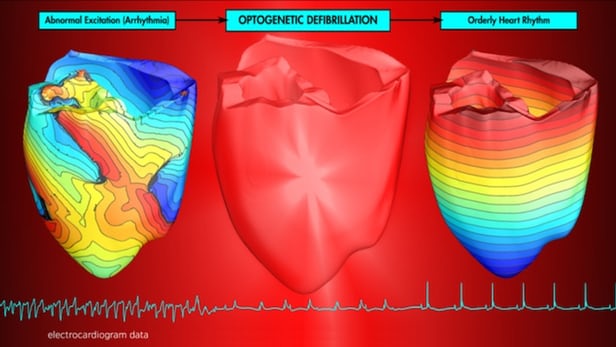
Current treatments for arrhythmia, a dangerous irregular heartbeat, involve administering an intense burst of electricity from a defibrillator in times of cardiac arrest, but these pulses are painful and potentially harmful. Now, in tests on mice and simulations of the human heart, scientists at Johns Hopkins and the University of Bonn have found that beams of light can restore regular heart function, possibly paving the way to implantable optical defibrillators that provide a gentle and safe alternative to a harsh electric shock.
The research comes from the field of optogenetics, which uses pulses of light to alter electrical activity in cells, thanks to implanted light-sensitive proteins. This field has, in the past, been used to deliver drugs to brain cells, study neurons and modify pain sensitivity. This study builds on previous research from some members of the team from Bonn, who used blue light to trigger arrhythmia in mice to learn about how to treat it.
For this research, the team went the other way: after engineering mice heart cells with proteins that react to light, they induced arrhythmia, then used one-second pulses of blue light to restore the cells to their regular rhythms.
"This is a very important result," says Tobias Bruegmann, one of the lead authors of the study. "It shows for the first time experimentally that light can be used for defibrillation of cardiac arrhythmia."
The team at Johns Hopkins, meanwhile, ran experiments on virtual human hearts to test whether the technique could be scaled up. Using a computer model crafted from MRI scans of a heart attack patient, the researchers found that it could prevent cardiac arrhythmia on the human scale, although the blue light used in the mouse trials wasn't strong enough to penetrate the thicker human tissue. Instead, the researchers opted for red light, which performed better thanks to its longer wavelength.
"In addition to demonstrating the feasibility of optogenetic defibrillation in a virtual heart of a patient, the simulations revealed the precise ways in which light alters the collective electrical behavior of the cells in the heart to achieve the desired arrhythmia termination," says Natalia Trayanova, supervisor of the research at Johns Hopkins.
As promising as these results are, the team acknowledges that there is still plenty of work to be done.
"We are working towards optical defibrillation of the heart, where light will be given to a patient who is experiencing cardiac arrest, and we will be able to restore the normal functioning of the heart in a gentle and painless manner," says Trayanova.
"The new method is still in the stage of basic research," says Philip Sasse, corresponding author of the study. "Until implantable optical defibrillators can be developed for the treatment of patients, it will still take at least five to ten years."

 Previous page
Previous page Back to top
Back to top







